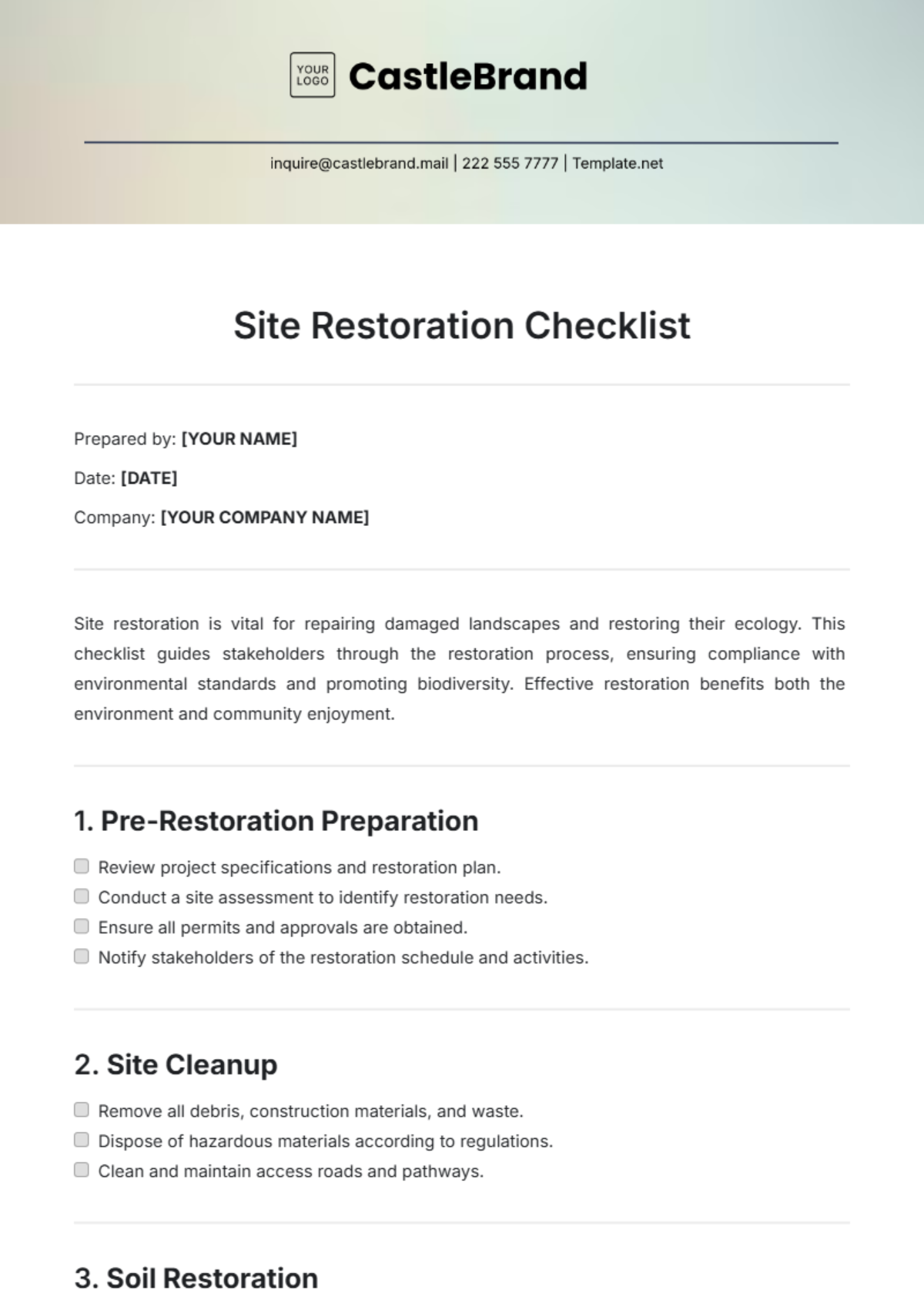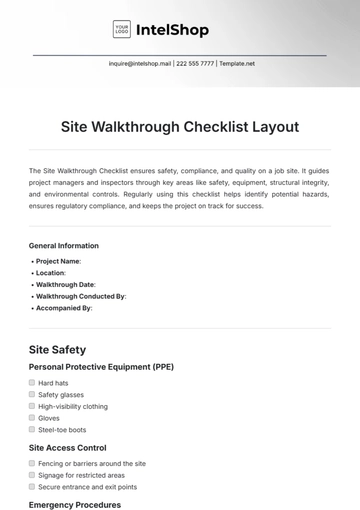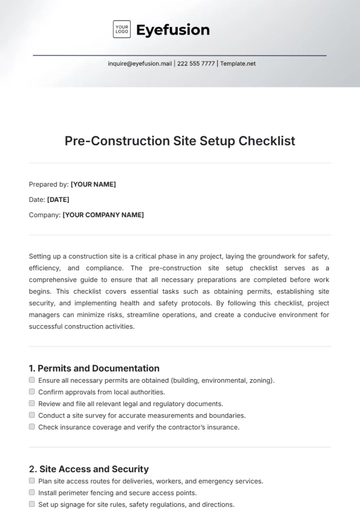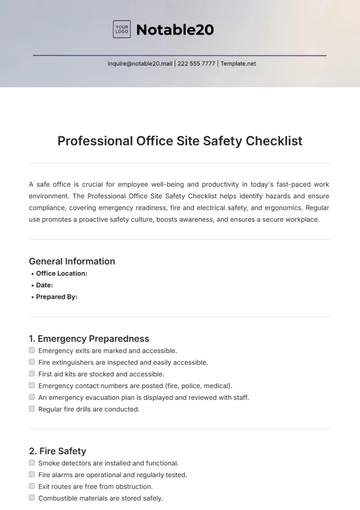Free Site Restoration Checklist

Prepared by: [YOUR NAME]
Date: [DATE]
Company: [YOUR COMPANY NAME]
Site restoration is vital for repairing damaged landscapes and restoring their ecology. This checklist guides stakeholders through the restoration process, ensuring compliance with environmental standards and promoting biodiversity. Effective restoration benefits both the environment and community enjoyment.
1. Pre-Restoration Preparation
Review project specifications and restoration plan.
Conduct a site assessment to identify restoration needs.
Ensure all permits and approvals are obtained.
Notify stakeholders of the restoration schedule and activities.
2. Site Cleanup
Remove all debris, construction materials, and waste.
Dispose of hazardous materials according to regulations.
Clean and maintain access roads and pathways.
3. Soil Restoration
Assess soil quality and amend as necessary (e.g., adding nutrients, pH adjustment).
Replace any removed topsoil in the designated areas.
Seed or sod bare soil areas with appropriate native vegetation.
4. Erosion Control
Install erosion control measures (e.g., silt fences, straw bales) as needed.
Stabilize slopes with vegetation or structural methods.
Ensure proper drainage is in place to prevent runoff.
5. Vegetation Restoration
Identify native plant species for replanting.
Plant native vegetation in disturbed areas according to the restoration plan.
Mulch around newly planted areas to retain moisture.
6. Wildlife Habitat Restoration
Create or restore habitats for local wildlife.
Install birdhouses or bat boxes if applicable.
Monitor for invasive species and manage as needed.
7. Infrastructure Restoration
Repair or replace damaged pathways, fencing, or signage.
Restore any existing structures (e.g., picnic areas, observation decks).
Ensure all utilities are functional and compliant with regulations.
8. Monitoring and Maintenance
Establish a monitoring plan to assess the success of restoration efforts.
Schedule regular maintenance (e.g., watering, weeding) for newly planted areas.
Document progress and any necessary adjustments to the restoration plan.
9. Final Inspection
Conduct a thorough site inspection to ensure compliance with restoration goals.
Review the checklist with all stakeholders for any additional comments.
Obtain final sign-off from relevant authorities or stakeholders.
10. Reporting
Prepare a final report documenting restoration activities and outcomes.
Include photographs and data on plant survival rates and wildlife activity.
Submit the final report to relevant stakeholders and regulatory agencies.
- 100% Customizable, free editor
- Access 1 Million+ Templates, photo’s & graphics
- Download or share as a template
- Click and replace photos, graphics, text, backgrounds
- Resize, crop, AI write & more
- Access advanced editor
You may also like
- Cleaning Checklist
- Daily Checklist
- Travel Checklist
- Self Care Checklist
- Risk Assessment Checklist
- Onboarding Checklist
- Quality Checklist
- Compliance Checklist
- Audit Checklist
- Registry Checklist
- HR Checklist
- Restaurant Checklist
- Checklist Layout
- Creative Checklist
- Sales Checklist
- Construction Checklist
- Task Checklist
- Professional Checklist
- Hotel Checklist
- Employee Checklist
- Moving Checklist
- Marketing Checklist
- Accounting Checklist
- Camping Checklist
- Packing Checklist
- Real Estate Checklist
- Cleaning Checklist Service
- New Employee Checklist
- Food Checklist
- Home Inspection Checklist
- Advertising Checklist
- Event Checklist
- SEO Checklist
- Assessment Checklist
- Inspection Checklist
- Baby Registry Checklist
- Induction Checklist
- Employee Training Checklist
- Medical Checklist
- Safety Checklist
- Site Checklist
- Job Checklist
- Service Checklist
- Nanny Checklist
- Building Checklist
- Work Checklist
- Office Checklist
- Training Checklist
- Website Checklist
- IT and Software Checklist
- Performance Checklist
- Project Checklist
- Startup Checklist
- Education Checklist
- Home Checklist
- School Checklist
- Maintenance Checklist
- Planning Checklist
- Manager Checklist
- Wedding Checklist
- Vehicle Checklist
- Travel Agency Checklist
- Vehicle Inspection Checklist
- Interior Design Checklist
- Backpacking Checklist
- Business Checklist
- Legal Checklist
- Nursing Home Checklist
- Weekly Checklist
- Recruitment Checklist
- Salon Checklist
- Baby Checklist
- Equipment Checklist
- Trade Show Checklist
- Party Checklist
- Hospital Bag Checklist
- Evaluation Checklist
- Agency Checklist
- First Apartment Checklist
- Hiring Checklist
- Opening Checklist
- Small Business Checklist
- Rental Checklist
- College Dorm Checklist
- New Puppy Checklist
- University Checklist
- Building Maintenance Checklist
- Work From Home Checklist
- Student Checklist
- Application Checklist





























